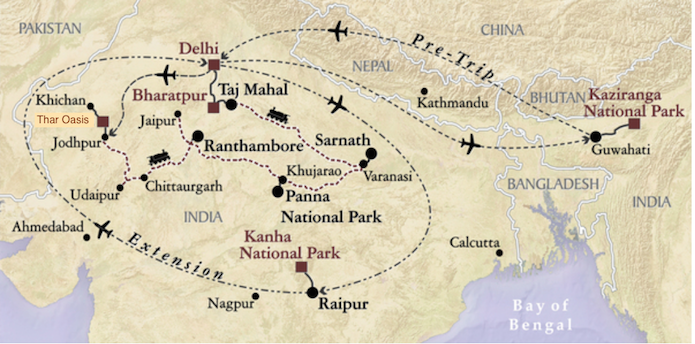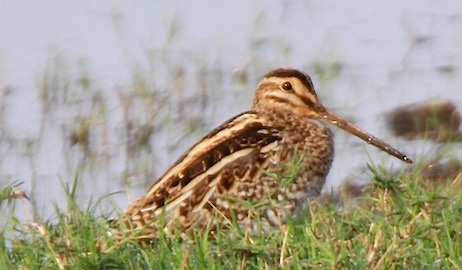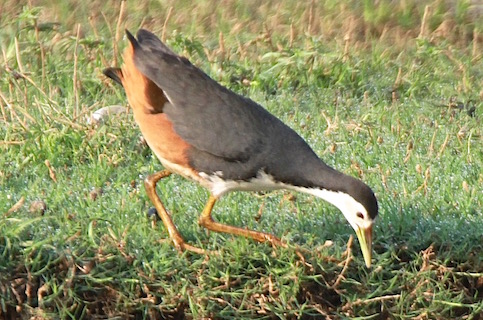
Overnight our train brought us to Ranthambore and later it continued on to Jaipur
(Image courtesy of VENT)
(Click on images to enlarge)


|
Today we explored the territories of Maharaja Sawai Jai Singh II, the creator of the Jantar Mantar astronomical observatories. We first looked for tigers and birds in his former hunting grounds, and then we toured his city (“Jaipur” means “city of Jai”) and the big fort his ancestors built on a hill above where he later built his city. |
|
We had to be up and ready to go by 6. After grabbing a few cookies in the
dining car, we were off in the dark aboard an open truck to be driven to
Ranthambore
National Park, a preserve created from the former hunting grounds of the
Maharajas of Jaipur. Our steward Keith had insisted that we take a blanket
along, but our fleeces were sufficient to deal with the “cold”.
(We keep hearing about how horrible the weather is back home and being glad we
were clever enough to schedule this trip, despite our not having given any
thought at all then to its potential for avoiding the worst of the winter.)
The sun had risen by the time we got to the national park. The park is especially wonderful in that it has the ruins of a massive 11th Century fort and associated buildings scattered about. Videos we’ve seen of the tigers in the park sometimes show them basking on the warm golden stone of the ruins. We did not, in the end, find any tigers today, but it was a glorious morning with wonderful birds and other wildlife, all of them very relaxed about visitors. |
Ranthambore National Park, Rajasthan |
| Perhaps the most relaxed were the Rufous Treepies, who overcame their innate shyness to greet us as soon as we arrived in the park. They are attracted to vehicles to the extent of perching on the bars over our heads and were quite willing to come to a hand to take food. We had as many as five at a time in attendance on us throughout the morning. |
|
Official Greeter, Ranthambore National Park |
 Rufous Treepie graciously accepting an offering |
| The rest of the wildlife was also accustomed to people. The white-phase Oriental Honey-Buzzard perched low in a tree eating something appeared not to mind our being so close. A Spotted Deer fawn browsed unconcernedly a few feet away from our vehicle. Other animals barely glanced up as we passed near them. |
|
Oriental Honey-Buzzard |
Spotted Deer fawn |
|
Samba Deer |
Wild Boar |
|
Spotted Deer |
Mugger Crocodile |
| And there were more terrific birds, such as the Spotted Owlet sound asleep in its hole. There were Peafowl everywhere, and we were surprised by how much gold they glinted in the bright sunlight (this is the first day we’ve been in India when the sky was actually blue). |
|
Sleeping Spotted Owlet |
Peacock |
| White-browed Wagtail was a dazzler. And I was thrilled to spot the Common Snipe (Gallinago gallinago!) at the edge of a pond we were surveying. Amy thanked me for “the only good photo of a snipe” she has ever taken—they are very cryptic and secretive usually. |
 White-browed Wagtail (Image courtesy of Amy Sheldon) |
 Common Snipe (Image courtesy of Amy Sheldon) |
| The White-breasted Waterhen was a lifebird for me, and it was good to get a much better look at the Asian Openbill. (At one place, we had an Asian Openbill sitting on a dead tree just above a White-throated Kingfisher with several other great birds within a few feet of those. It became hard to keep up with the birds as Dion called them.) |
 White-breasted Waterhen (Image courtesy of Amy Sheldon) |
 Asian Openbill (Image courtesy of Amy Sheldon) |
|
We paused in our drive so everyone could try for the canonical photo of Spotted
Deer in front of a pink pavilion. This is Lee’s:
Spotted Deer and reflections, Ranthambore National Park |
| There were Hanuman Langurs (Northern Plains Grey Langurs) all over the park, especially around the entrance. As we were leaving the park, we paused to see a mother who was nursing a tiny infant. Our luck with raptors continued just outside the park, where we had a killing view of a Crested Serpent Eagle. |
|
Hanuman Langurs |
Crested Serpent Eagle |
|
(To see some exceptionally good photographs of the wildlife of Ranthambore, I
suggest you look at
Craig Jones’s page.)
We were all ready for breakfast when we got back to the train. I daringly chose the Puri-Bhaja, which proved to be among the best food we’ve had on the trip. At breakfast, a very kind-hearted companion, who had realized from Lee’s awful cough that he has bronchitis, gave him her stash of antibiotics, and he took the first dose right away. I was so grateful to her! After breakfast, Dion gave us the not-so-good news that once we got to Jaipur, the train would be taken to the yards for servicing and wouldn’t be available to us again until 9:30 in the evening. He’d not been told about this change until today so had been scrambling to figure out how to amuse us for all that time. (The plan had been for us to come back on board in the middle of the afternoon, which I’d been looking forward to after our early start.) After Dion finished going over the program for the day, I did about a three-minute introduction to the Jantar Mantar and Sawai Jai Singh II, in the hope of getting our companions interested enough to allow us more time to savor the Jantar Mantar when we arrived in Jaipur. By then the train was moving, so we had about an hour to rest, recharge batteries, etc. Lee and I watched through the windows as the train approached Jaipur and noted much home-based small industry, including cloth dying, in the outskirts of the city. The population of Jaipur is about half that of New York City, so it is a considerable town. |
|
City Gates, Jaipur |
Detail of City Gates, Jaipur |
| Our first stop in Jaipur was at the Jantar Mantar. This is where Sawai Jai Singh II did much of his own astronomical work and had some of his best instruments. He constructed the instruments between 1725 and 1738. In 1901, the then Maharaja of Jaipur, Madho Singh II (who was the adoptive son of Jai Singh’s great-great-great-grandson) arranged to have them restored. The restoration was led by Lieutenant A. ff. Garrett, who clearly understood the instruments well. Garrett wrote that he did the work “entirely with Jaipur labour, materials and workmanship.” The results are beautiful. (If you want to see more, here are a 13-second clip and a two-minute walkthrough.) |
|
Cakra Yantra (bronze, in foreground) and Rama Yantra (left) Jantar Mantar, Jaipur |
Nadivalaya Yantra (for determining the equinoxes) Jantar Mantar, Jaipur |
|
Rasivalaya Yantras (a “sundial” for each sign of the zodiac) Jantar Mantar, Jaipur |
Gnomon and scale of the Great Samrat (sundial) Jantar Mantar, Jaipur |
|
I was overjoyed at the chance to see it all and to see how really well preserved it is. I ran around like a mad thing trying to take in everything in the short time we had. It was nice to see that the scale of the Great Samrat here is not buried in concrete as in Delhi (though it is shadowed by nearby buildings to some extent). Questions I’d had about how some of the instruments worked were answered when I could examine their scales hurriedly. I wanted to jump over some of the fences to get a better look here and there, but restrained myself. It was nifty that the sky was clear enough here (unlike in Delhi) that we could actually see the shadow of the circular marker suspended by crosswires above the hemispherical Jaya Prakasa. An observer standing in one of the walkways of this instrument could readily make an exact measurement of where the opening in the marker’s shadow fell on the scale and, thus, of the Sun’s altitude and azimuth. More interestingly, at night an observer with a sighting tool (a tube with a mirror and eyepiece) could walk through the instrument and place the sighting tool on the scales to line it up so that the star or planet of interest could be seen through the opening in the marker overhead, thus determining the position of the object in the sky very precisely. Jai Singh’s big contribution to this method was to replace the traditional single, solid instrument with two complementary Jaya Prakasa with walkways. He built them side-by-side, so that when the object in question moved from the scale to a walkway of one instrument, the observer could move to the other instrument, where the object would have just moved from a walkway to the scale. |
|
Suspended marker (blue arrow) and its shadow (red arrow) Jaya Prakasa Yantra, Jantar Mantar, Jaipur |
Detail of shadow Jaya Prakasa Yantra, Jantar Mantar, Jaipur |
| I would love to have had a couple of hours at the Jantar Mantar, but Dion extended the time as much as he could for us, and it was a real treat. From there, we were led to the nearby City Palace, which was built by, of course, Sawai Jai Singh II. The palace is a pretty fluff of pink and white with peacock decorations and elephant sculptures and many touches derived from the Taj Mahal, such as the stone inlays of flowers. (The Taj was completed about 80 years before this palace was begun. Jai Singh would have known the Taj well; he created the best map we have of Mughal-era Agra.) |
 Chandra Mahal, Jaipur City Palace |
 Diwan-I-Khas (audience hall), Jaipur City Palace |
|
Peacock Gate, Jaipur City Palace |
Elephant sculpture and stone inlays, Jaipur City Palace |
| Then it was time for our trip to the magnificent Amber Fort, built by Sawai Jai Singh II’s great-great-great-great-great-grandfather, Raja Man Singh I, whose war elephant mortally wounded the famous horse of Udaipur, Chetak. (By then, the Rajas of Amber/Jaipur were liegemen of the first Mughal Emperor, Akbar.) |
| The fort itself was magnificent, and the great wall passing along the ridges around it was even more so. The buildings are an interesting mixture of Mughal and traditional, very handsome indeed. I particularly liked the rooftop gardens that must have been much more splendid in olden times. |
|
Walls of Amber Fort |
Diwan-e-Aam (Hall of Public Audience), Amber Fort |
|
Ganesh Pol (Ganesha Gate), Amber Fort |
Detail of Ganesh Pol, Amber Fort |
|
Flower carving, Mirror Palace, Amber Fort |
Gardens, Amber Fort |
 Interior of Raj Mandir Cinema, Jaipur |
We drove back into the city as the sun set. Earlier, Dion had told us that
he had a surprise in store for us and Lee had made me cringe by teasing me that
it was going to be the sound and light show at the Jantar Mantar for which
we’d seen an ad. Instead, we were taken to a
glamorous movie theater to sample a
Bollywood film. I think Dion was disappointed that the movie was not really
typical of Bollywood. Though there was singing and dancing, there was much
gratuitous (though not very explicit) sex and violence. By the intermission,
the consensus was that it was time to leave. An Indian family in the row
behind us apologized for this not being a good Indian movie, adding
that they didn’t like it at all. Lee and I had watched a couple of the
more typical Bollywood films in preparation for the trip, but in those cases we
had the advantage of subtitles, so we understood them a lot better.
Crossing the street to get back to our bus, we had to deal not only with the mad traffic but also with people trying to sell us stuff right in the middle of the road while we were dodging cars and motorcycles. It seemed insane, but nobody got hit, so all was well. |
| Comb Duck | Ruddy Shelduck | Northern Shoveler | Garganey | Green-winged Teal |
| Grey Francolin | Indian Peafowl | Asian Openbill | Great Cormorant | Little Cormorant |
| Oriental Darter | Grey Heron | Purple Heron | Eastern Great Egret | Indian Pond Heron |
| Black-headed Ibis | Oriental Honey-Buzzard | Crested Serpent Eagle | Shikra | White-breasted Waterhen |
| Common Moorhen | Great Thick-knee | Black-winged Stilt | Red-wattled Lapwing | Little Ringed Plover |
| Common Snipe | River Tern | Rock Pigeon | Eurasian Collared Dove | Spotted Owlet |
| Little Swift | Common Kingfisher | White-throated Kingfisher | Pied Kingfisher | Black-rumped Flameback |
| Rose-ringed Parakeet | Black Drongo | White-browed Fantail | Rufous Treepie | House Crow |
| Ashy-crowned Sparrow-Lark | Dusky Crag Martin | Red-rumped Swallow | Cinereous Tit | Red-vented Bulbul |
| Plain Prinia | Jungle Babbler | Blue Rock Thrush | Bank Myna | Common Myna |
| Asian Pied Starling | White-browed Wagtail |

